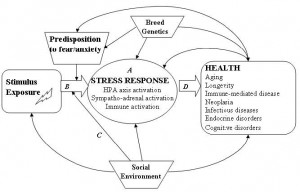We’ve all seen it: the dog that’s super-excited and the one that cowers in a corner; the one that never stops barking and the one that never leaves your side. But while all these dogs may look completely different, what their behaviour is saying may be virtually the same. They’re telling you, their owner and the world, they’re anxious.
Canine anxiety is super common, and it’s also often ignored. That ignorance isn’t necessarily because people don’t care, it’s more likely that people don’t recognise anxious behaviour.
In an interview on Pet Parent with a Brain recently, a Facebook series that delves into the science of all things dog and cat, Holistic vet Dr Kathy Cornack from Holistic Vets Newcastle
said that while there are obvious indicators like separation anxiety, by and large, most people don’t recognise the signs. For example, if your dog follows you from room to room, it may not be because they love you.
“People love that, don’t they…but that can be another hallmark; they don’t have the resilience to hang out by themselves.”
She says that another example she sees all the time, is when the dog gives a big yawn. “Everyone goes, oh, you’re tired,” she says. “I tell them, no, the dog’s not tired; that’s what we call a calming signal.”
A calming signal is part of a dog’s language. It’s the way they communicate with each other and the way they’re trying to communicate with you. In fact, according to Turid Rugaas, the Norwegian canine behaviourist and dog trainer credited with coining the term, there are about 30 calming signals that a dog will use; from yawning to bowing to sniffing the ground. The signal is their attempt to stop whatever they feel is threatening or stressful for them. You can read more about the calming signals here.
Anxiety checklist: some other behaviours to look for
If you’re a dog walker, groomer or a pet sitter, for instance, it may be helpful for you to identify signs of anxiety – that pet parents aren’t seeing. They include:
• Yawning and lip licking
• Ears flattened against the head, tail down and often tucked between the legs
• Submissive behaviour: lying down on its side, lifting a hind leg, displaying the abdominal area, and sometimes urinating
• Aggressive posture: raised fur on the shoulders and over the rump and lips retracted in a snarl
• Often disinterested in food, play, or other interactions
• Panting, drooling, weeing and pooing
• Pacing, digging, destructiveness, excessive licking
• Hiding, shedding, and whining
There may also be multiple, conflicting signs at the same time!
So, if you do see these signs, what should you do? Ignore it? It may be confronting having that conversation with a client, but it would be better for the dog’s health, and ultimately the client, if they knew about it, and addressed it.
The impact of anxiety and stress on health is serious and won’t go away on its own
Stress of one kind or another – fear of thunderstorms, separation anxiety, stranger fear – can set off a complex chain of events. If we look at the diagram below , we can see there are multiple triggers, and in some cases predispositions, that set off a domino-like effect in the dog.

This can lead to both short and long term effects on the health and life-span of the dog: accelerated aging, shortened lifespan, increased immune-mediated diseases and other disorders. For example:
- Stress affects the skin: While acute stress promotes wound healing by increased local inflammation and white blood cell mobilization, chronic stress suppresses interferes with wound healing. Increased stress has also been correlated with disruption of the epidermal barrier function, which in turn, may lead to inflammatory skin disorders.
- Stress affects weight: One thing that stress-related hormones do is mobilise energy stores to provide fuel for an animal in distress. A consequence of chronic stress, therefore, is high energy stores, increased appetite, and food seeking-behaviour. Because the body may not burn off the energy that’s been mobilised, long term effects of stress can include obesity, insulin resistance and diabetes, and cardiovascular disease.
- Stress affects the brain: Short term stress may enhance the ability to store information, but it also leaves the brain susceptible to injury. Long term stress results in hippocampal neuron loss resulting in memory loss, and over a long period of time, to cognitive defects, including learning and memory problems, as well as depression and anxiety.
How can you help your clients manage their dogs’ anxiety?
According to Dr Cornack, dealing with anxiety isn’t the time to only consult Dr Google and come up with a DIY plan.
“It’s like seeing a psychologist for yourself,” she says. “You go frequently for a while and then, not so much, until you need them again. And you need to find people that can be like the psychological health partner for your dog, and give them ongoing life support as they move through the different phases.”
So clients should consult a professional – a vet or trainer for instance. Diet is also important. One easy thing that clients could do, as well as undertaking training, is add a natural immune booster to their dog’s diet, to help them better manage anxiety, and stress.
One suggestion is Bestie Kitchen’s Tropical Wonder, a superfood blend of papaya and medicinal mushrooms, that has anti-inflammatory and immunomodulatory properties, to help support wellness and immune system health. Dr Cornack, who helped develop the formulation, is a big believer in ‘papaya power’.
“I commonly recommend papaya to be fed to all dogs as a healthy boost to the diet,” she says. “It is jammed packed full of goodness and health benefits. We should all have some every day too!”
Reference: THE BIOBEHAVIORAL EFFECTS OF STRESS RELATED TO FEAR AND ANXIETY IN DOMESTIC CANINES: A Thesis in Behavioural Health by Nancy A. Dreschel. She went on to write Dreschel, Nancy. (2010). The effects of fear and anxiety on health and lifespan in pet dogs. Applied Animal Behaviour Science. 125. 157-162. 10.1016/j.applanim.2010.04.003 – unavailable except in abstract.
Liz Walden
Latest posts by Liz Walden (see all)
- Assessing your insurance risks - October 29, 2021
- 4 questions to ask about professional indemnity insurance - October 29, 2021
- Public Liability vs. Professional Indemnity: What’s the difference? - April 26, 2021











Leave A Comment